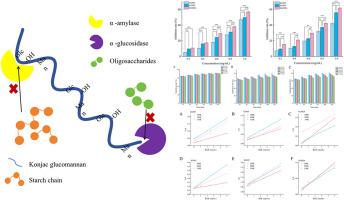魔芋葡甘露聚糖对淀粉消化率的影响:性质与动态的深入探讨
IF 11
1区 农林科学
Q1 CHEMISTRY, APPLIED
引用次数: 0
摘要
多糖的分子量(Mw)显著调节淀粉酶解的动力学和程度。探讨了不同分子量魔芋葡甘露聚糖(KGM)对淀粉消化的调控机制。结果表明,KGM能有效降低淀粉水解率,提高抗性淀粉(RS)含量,且具有明显的Mw依赖性,其中添加较高Mw的样品(Mw为2406 KDa)可使抗性淀粉(RS)含量最大提高11.82%。KGM对α-葡萄糖苷酶的抑制效果优于α-淀粉酶,抑制率可达62.5%。分子对接模拟进一步表明,KGM占据了α-淀粉酶和α-葡萄糖苷酶的催化口袋,建立了稳定的氢键网络。荧光猝灭机制表明,较小Mw的KGM对两种酶都具有静态猝灭作用,而较大Mw的KGM则具有动态猝灭作用。随着KGM分子量的增加,酶的β-sheet和α-helix含量升高,β-turn结构减少,分别减少8.72%和4.10%。本研究为开发精准血糖控制食品、优化食品功能特性,促进健康饮食,预防和控制慢性疾病提供了基础。本文章由计算机程序翻译,如有差异,请以英文原文为准。

Impact of konjac glucomannan on starch digestibility: An in - depth exploration of properties and dynamics
The molecular weight (Mw) of polysaccharides significantly modulates both the kinetics and the extent of enzymatic starch digestion. The regulatory mechanism of konjac glucomannan (KGM) with different Mw was explored on starch digestion in this investigation. Results displayed that KGM could effectively diminished the starch hydrolysis rate and elevated resistant starch (RS) content in a pronounced Mw-dependent manner, while the supplementation of samples with the higher Mw (Mw of 2406 KDa) facilitated the maximal increase of 11.82 % in RS content. The inhibition of KGM on α-glucosidase demonstrated superior efficacy to that of α-amylase, with an inhibition rate of up to 62.5 %. Molecular docking simulations further indicated that KGM occupied the catalytic pockets of both α-amylase and α-glucosidase, establishing stable hydrogen-bond networks. The fluorescence quenching mechanism revealed that smaller Mw KGM induced a static quenching effect on both enzymes, while larger Mw KGM exhibited a dynamic quenching effect. The enzyme exhibited elevated β-sheet and α-helix contents accompanied by a concomitant decline in β-turn structures as the Mw of KGM increased, with reductions of 8.72 % and 4.10 %, respectively. In conclusion, this study provided a foundation for developing precise glycemic control foods and optimizing food functional properties, which could promote healthy diets and help prevent and control chronic diseases.
求助全文
通过发布文献求助,成功后即可免费获取论文全文。
去求助
来源期刊

Food Hydrocolloids
工程技术-食品科技
CiteScore
19.90
自引率
14.00%
发文量
871
审稿时长
37 days
期刊介绍:
Food Hydrocolloids publishes original and innovative research focused on the characterization, functional properties, and applications of hydrocolloid materials used in food products. These hydrocolloids, defined as polysaccharides and proteins of commercial importance, are added to control aspects such as texture, stability, rheology, and sensory properties. The research's primary emphasis should be on the hydrocolloids themselves, with thorough descriptions of their source, nature, and physicochemical characteristics. Manuscripts are expected to clearly outline specific aims and objectives, include a fundamental discussion of research findings at the molecular level, and address the significance of the results. Studies on hydrocolloids in complex formulations should concentrate on their overall properties and mechanisms of action, while simple formulation development studies may not be considered for publication.
The main areas of interest are:
-Chemical and physicochemical characterisation
Thermal properties including glass transitions and conformational changes-
Rheological properties including viscosity, viscoelastic properties and gelation behaviour-
The influence on organoleptic properties-
Interfacial properties including stabilisation of dispersions, emulsions and foams-
Film forming properties with application to edible films and active packaging-
Encapsulation and controlled release of active compounds-
The influence on health including their role as dietary fibre-
Manipulation of hydrocolloid structure and functionality through chemical, biochemical and physical processes-
New hydrocolloids and hydrocolloid sources of commercial potential.
The Journal also publishes Review articles that provide an overview of the latest developments in topics of specific interest to researchers in this field of activity.
 求助内容:
求助内容: 应助结果提醒方式:
应助结果提醒方式:


